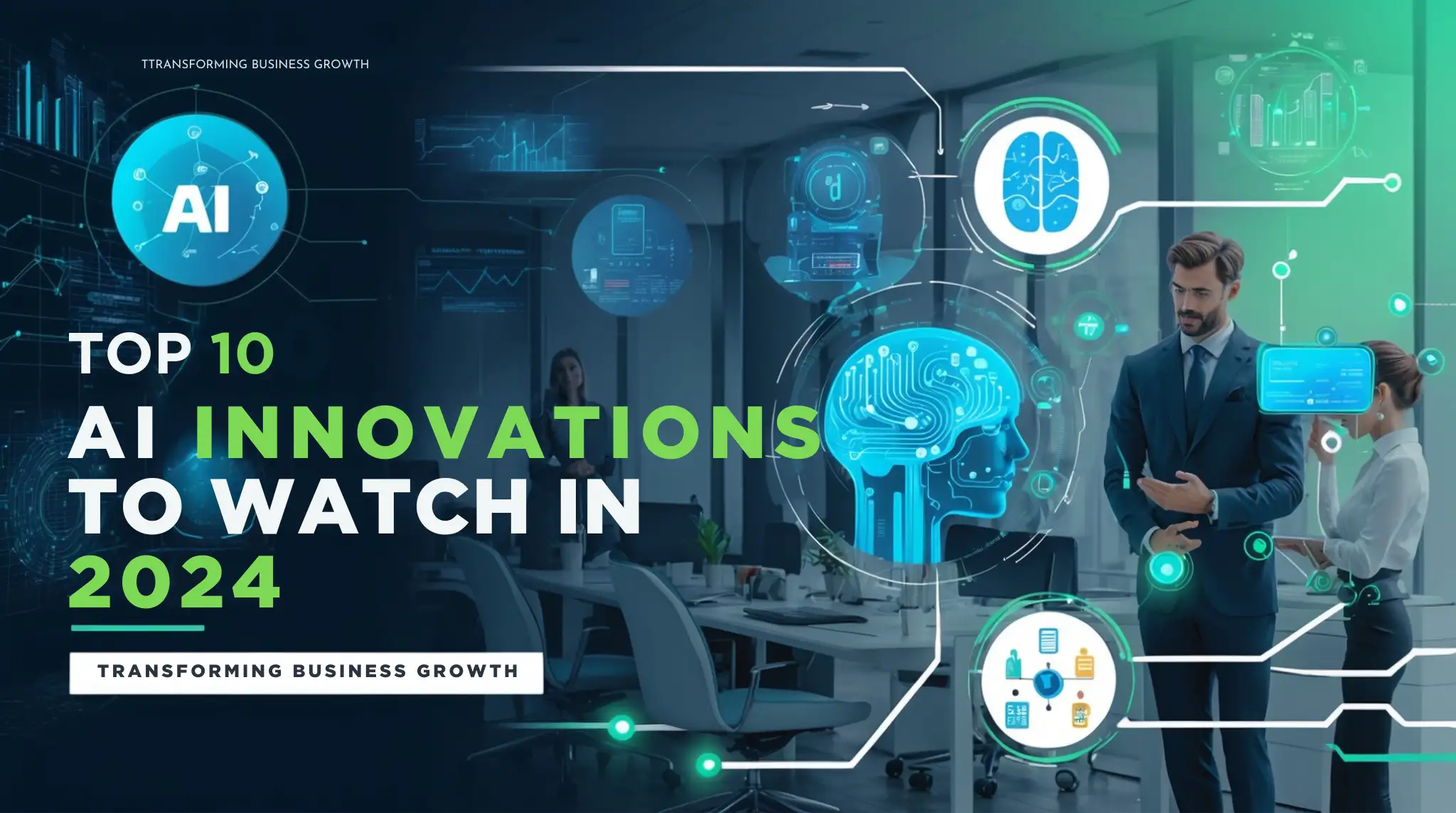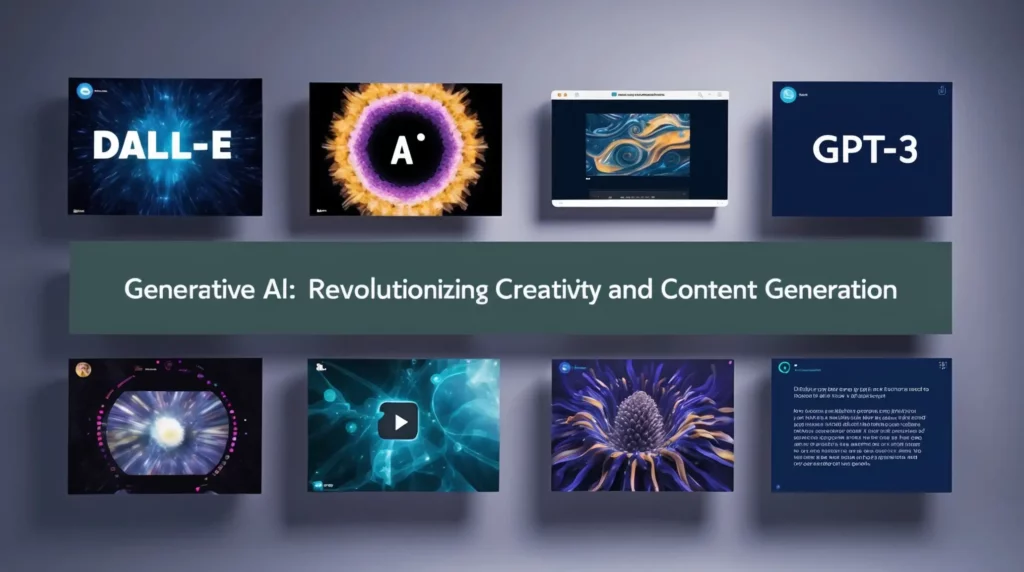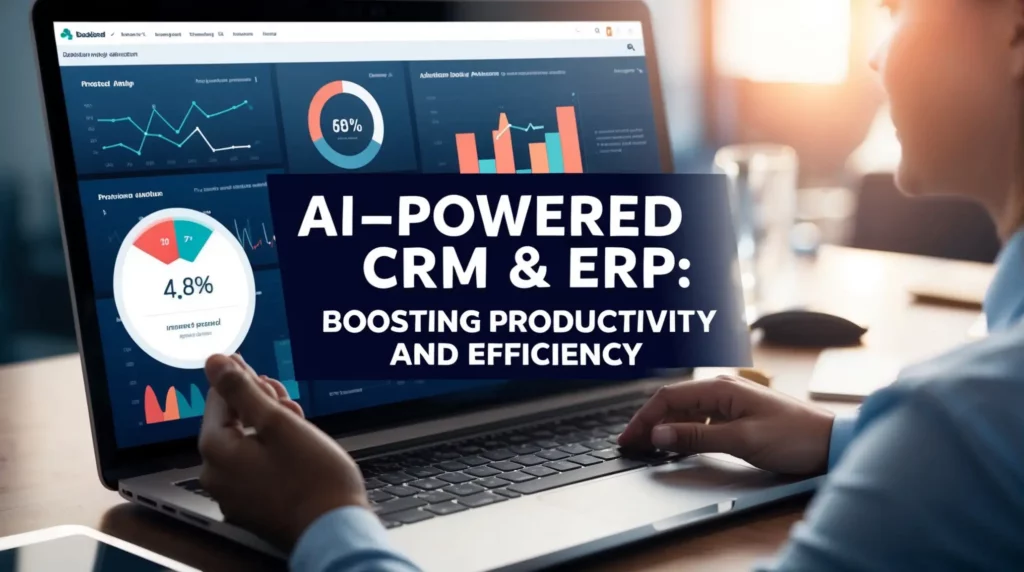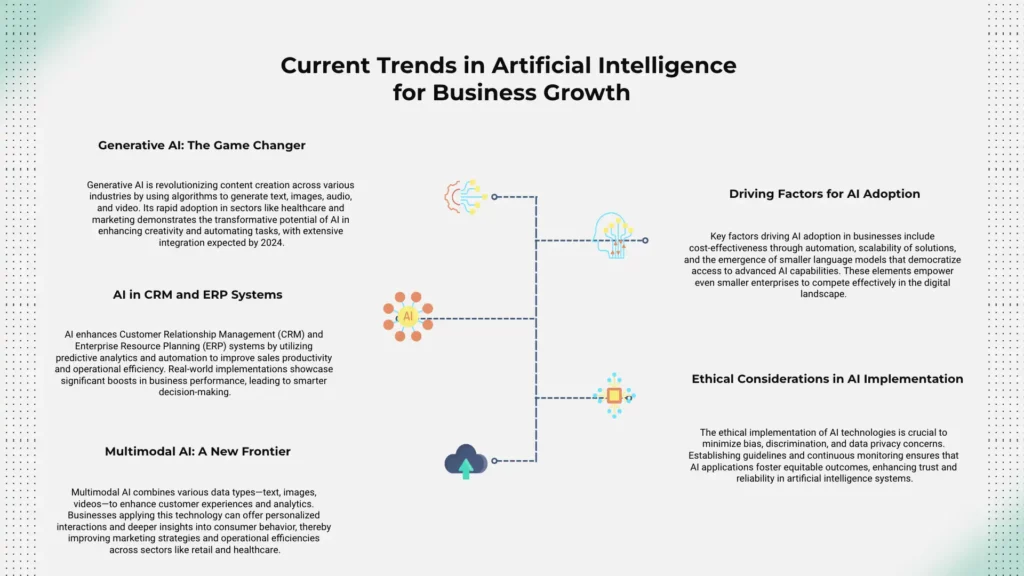Current Trends in Artificial Intelligence for Business Growth: Top 10 Innovations to Watch in 2024

Our audience supports Ahcrypto. When you click on the links on our site, we may earn an affiliate commission at no extra cost to you. Learn More.
Introduction
Businesses are increasingly using current trends in artificial intelligence to drive growth and innovation. AI technologies are transforming various sectors, enhancing productivity, and enabling new capabilities.
Key takeaway: Embracing these AI innovations for business growth will provide a significant competitive edge in the market.
For instance, artificial intelligence’s transformative power is being used in e-commerce, revolutionizing the customer experience and retailer operations. Additionally, AI is playing a crucial role in advancing sustainability goals, helping businesses reduce their environmental impact while driving efficiency.
1. Generative AI: The Game Changer

Generative AI is a technology that has been making a big impact since 2022. It uses algorithms to create new content—like text, images, audio, and even video—based on the data it has learned from. Some examples of generative AI are OpenAI’s GPT-3 for generating text and DALL-E for creating images.
Rapid Adoption Across Sectors
Since it was first introduced, generative AI has quickly been adopted in various industries:
- Healthcare: Developing synthetic medical data to enhance research while keeping patient information private.
- Marketing: Creating personalized content and advertisements.
- Entertainment: Generating scripts and storyboards.
Projected Integration by 2024
By 2024, generative AI is expected to become a regular part of everyday business activities. Companies will use it for:
- Automated content creation
- Improved customer interaction
- Designing and prototyping products
Key Benefits for Businesses
The main advantages of generative AI for businesses are:
- Increased Creativity: It helps companies come up with new ideas and solutions.
- Content Generation: It automates the process of creating large amounts of high-quality content.
For more insights on how AI is transforming different industries, including logistics, where it provides real-time insights and predictive analytics, check out this article on AI in Logistics: Top Use Cases and Industry Role.
Businesses investing in AI are setting themselves up for significant competitive advantages. However, with these innovations come risks that need to be managed effectively. Explore AI Risk Management: Your Framework for Success to understand how to navigate the challenges associated with the successful use of artificial intelligence.
2. AI in CRM and ERP Systems

The integration of AI into Customer Relationship Management (CRM) and Enterprise Resource Planning (ERP) systems is transforming business operations. AI in CRM leverages predictive analytics and automation to enhance functionalities, offering deeper insights into customer behavior and preferences.
Key enhancements include:
- Predictive Analytics: AI algorithms analyze historical data to predict future trends, helping businesses make informed decisions.
- Automation: Routine tasks are automated, freeing up time for employees to focus on strategic initiatives.
Improvements in data sharing and collaboration are notable. AI-powered systems facilitate seamless information flow across departments, ensuring that everyone has access to the most up-to-date data.
Real-world examples demonstrate the impact of AI on sales productivity and operational efficiency:
- A leading retail company reported a 20% increase in sales productivity after implementing an AI-driven CRM system.
- An international logistics firm experienced a 15% boost in operational efficiency by integrating AI into its ERP system.
For more on how AI is revolutionizing different sectors, you might find our exploration of AI in finance insightful. Also, delve into AI’s role in cybersecurity for a comprehensive understanding of its broader impacts.
3. Multimodal AI: A New Frontier

Multimodal AI integrates different types of data—text, image, and video—to create more intuitive virtual assistants and improve learning capabilities. This approach allows AI systems to process and analyze information from multiple sources simultaneously, providing a richer, more comprehensive understanding of the data.
Benefits for Businesses
Businesses leveraging multimodal AI and generative AI can significantly enhance customer experiences through personalized interactions. By staying updated with current trends in AI, key benefits include:
- Enhanced Customer Engagement: By processing various data forms, multimodal AI can offer more relevant and timely responses, leading to improved customer satisfaction.
- Advanced Analytics: The ability to analyze text, images, and videos together provides deeper insights into customer behavior and preferences, enabling more effective marketing strategies.
Industry Applications
Different sectors are rapidly adopting multimodal AI:
- Retail: Retailers use multimodal AI to create immersive shopping experiences. For instance, virtual fitting rooms combine visual data with customer preferences to suggest the best products.
- Healthcare: In healthcare, multimodal AI assists in diagnosing diseases by analyzing medical images alongside patient history and symptoms documented in text form.
For a deeper dive into how these technologies are changing industries, explore Big Data and AI: Strategic Integration for Success.
Incorporating multimodal AI is not only about technology but also about trust. Learn how trust is built in AI systems by visiting AI Trust: Ensuring Ethical and Reliable AI Systems.
4. Driving Factors for AI Adoption
Businesses are increasingly adopting AI technologies due to several compelling factors:
1. Cost-effectiveness and scalability
AI solutions can automate routine tasks, reducing the need for human intervention and cutting operational costs. Scalable AI platforms enable businesses to handle growing data volumes without proportional increases in investment.
2. Smaller language models
These models offer significant benefits for organizations with limited resources. They require less computational power and can be efficiently deployed, making advanced AI capabilities accessible to a broader range of businesses. No-code AI platforms and narrow AI solutions further simplify the implementation process, allowing even those without extensive machine learning expertise to leverage these powerful tools.
The rise of open-source models, driven by current trends in artificial intelligence and the future of AI, has democratized access to advanced AI tools, allowing organizations to innovate without incurring prohibitive costs. Accessible tools for automation streamline various business processes, enhancing productivity and efficiency. Staying updated with AI and machine learning trends and enrolling in a post-graduate program can further equip professionals to leverage these advancements effectively.
Explore more about how common misconceptions around AI are debunked in this insightful article on debunking common AI myths and misconceptions.
Moreover, the impact of AI is not just limited to businesses but also extends to our urban living. Discover how AI and IoT are revolutionizing urban living in sustainable smart cities in this detailed exploration about AI’s revolutionary impact on urban living.
5. Ethical Considerations in AI Implementation

Implementing AI solutions requires strict adherence to ethical guidelines to mitigate risks associated with bias and discrimination. These guidelines serve as a foundation for responsible innovation practices, ensuring that AI technologies are deployed fairly and transparently.
Key Challenges:
- Data Privacy Concerns: Protecting user data is crucial. Various use cases of artificial intelligence, from customer support to predictive analytics, require strong data privacy measures. Mishandling data can lead to breaches and loss of trust.
- Bias and Discrimination: AI algorithms must be designed and tested to avoid perpetuating biases present in training datasets. This requires ongoing monitoring and adjustments to ensure equitable outcomes.
Ensuring data integrity throughout the AI implementation process enhances the reliability and trustworthiness of AI systems. Furthermore, it’s essential to recognize that ethical considerations in AI implementation are not just about avoiding harm; they also involve actively promoting positive outcomes. For instance, by following ethical guidelines, businesses can leverage AI’s potential to drive significant advancements in areas such as healthcare. As highlighted in this study, AI can improve diagnostic accuracy, personalize treatment plans, and streamline administrative processes in healthcare settings when implemented ethically and responsibly.
6. Investment Trends and Market Statistics
Investment Trends in AI
Despite economic challenges across various industries, investment in AI technologies remains robust. The demand for AI-driven solutions, fueled by current trends in artificial intelligence, continues to grow as businesses seek to enhance efficiency and innovation.
Despite economic challenges across various industries, investment in AI technologies remains robust. The demand for AI-driven solutions, including multi-modal machine learning and reinforcement learning, continues to grow as businesses seek to enhance efficiency and innovation. Additionally, the rise of low-code/no-code machine learning platforms is making it easier for companies to implement these advanced technologies without extensive technical expertise.
- Current Landscape: Investors are particularly interested in generative AI, which has seen a sevenfold increase in funding. This surge highlights the technology’s potential to transform numerous sectors.
- Future Spending: Recent market research reports predict that global spending on AI solutions could exceed $500 billion by 2027. This projection underscores the sustained confidence in AI’s capacity to deliver significant business value.
You can learn more about the impact of AI predictive analytics on business decisions, a key area of investment, by visiting AhCrypto. Additionally, exploring the latest SaaS trends for 2024 can offer insights into how AI innovations are shaping the industry landscape.
7. Skills Development for an AI-Powered Workforce
Artificial intelligence, driven by current trends in artificial intelligence, is not just transforming business operations but also reshaping the workforce. The rise of AI technologies has led to the creation of new job roles that require specialized skills and knowledge.
Emerging Roles in AI
Several new roles have emerged due to the integration of AI:
- AI Ethicists: Professionals who ensure AI systems are designed and implemented ethically, mitigating risks of bias and discrimination.
- AI Integrators: Specialists who integrate AI solutions into existing business processes, ensuring smooth transitions and maximizing efficiency.
- AI Trainers: Experts responsible for training AI models, improving their accuracy and performance through continuous learning.
- Compliance Managers: Individuals tasked with ensuring that AI implementations adhere to legal and regulatory standards.
Skills Development
To support these emerging roles, businesses must focus on developing relevant skills within their workforce:
- Technical Proficiency: Understanding of machine learning algorithms, data analysis, and software engineering.
- Ethical Awareness: Knowledge of ethical guidelines and practices in AI implementation.
- Project Management: Ability to manage AI projects from conception to deployment.
Investing in skills development will be crucial for businesses aiming to harness the full potential of AI technologies. For instance, harnessing AI for sustainability project management can optimize project management, reduce carbon footprints, and drive businesses toward a more sustainable future.
Additionally, exploring no-code platforms can significantly aid in creating custom AI solutions without extensive coding expertise. You can learn more about the top 10 no-code SaaS tools that can help build your MVP without coding.
8. Cloud Integration with Artificial Intelligence

Combining cloud technology with AI tools offers numerous benefits, especially in terms of enhanced data management and scalability. This integration allows businesses to leverage the power of scalable cloud platforms to store, process, and analyze massive amounts of data efficiently.
Key Benefits:
- Enhanced Data Management: Cloud-based AI solutions streamline data collection, storage, and analysis. They enable real-time access to data, improving decision-making processes.
- Scalability: Cloud platforms provide a flexible infrastructure that can scale according to business needs. This is particularly beneficial for businesses with fluctuating workloads or those experiencing rapid growth.
Industry Examples:
- Retail Sector: Companies like Amazon use cloud-integrated AI for inventory management and customer insights, leading to improved customer satisfaction and operational efficiency.
- Healthcare Industry: Organizations are leveraging cloud-based AI tools for patient data analysis and personalized treatment plans, significantly enhancing patient care quality.
For more insights on building an effective AI strategy for your organization, which can help avoid biases in decision-making, consider exploring the resources available at AhCrypto.
9. Future Innovations: Low-Code/No-Code Platforms
Low-code/no-code development platforms are changing the way businesses create custom software solutions. These platforms allow non-technical users to build customized processes without needing extensive programming knowledge. This shift in software development empowers businesses to adapt to market changes quickly, encourages innovation, and reduces reliance on specialized IT teams.
Key benefits include:
- Accessibility: Non-developers can build applications, encouraging a broader range of employees to contribute to digital transformation efforts.
- Efficiency: Reduces the time required to develop and deploy custom solutions, speeding up business processes.
- Cost-effectiveness: Minimizes the need for professional developers, cutting down on labor costs.
Examples of popular low-code/no-code platforms include OutSystems, Mendix, and Microsoft Power Apps, which offer user-friendly interfaces and robust features. By leveraging these tools, businesses can stay agile and responsive in a rapidly evolving technological landscape. Additionally, low-code platforms are becoming increasingly popular due to their ability to streamline application development processes.
10. Long-term Strategies for Successful Adoption
Aligning AI strategies with business goals is crucial for sustainable growth. Businesses must ensure that their AI initiatives are not isolated projects but are integrated into the company’s broader objectives. This alignment helps drive consistent value and achieve measurable outcomes.
Key considerations include:
- Data-Driven Culture: Foster a culture where data informs decision-making at all levels.
- Human-AI Collaboration: Encourage collaboration between human employees and AI systems to leverage the strengths of both.
- Continuous Learning and Adaptation: Establish mechanisms for continuous learning and adaptation to keep up with technological advancements.
- Governance and Compliance: Implement robust governance frameworks to ensure ethical use and compliance with regulations.
These strategies promote a holistic approach, ensuring that AI technologies, aligned with current trends in artificial intelligence, contribute effectively to the long-term success of the organization.
Conclusion
Embracing these trends in artificial intelligence for business growth can significantly enhance your competitive edge. From Generative AI to AI-integrated CRM and ERP systems, the innovations poised to shape 2024 are vast. Key investments, ethical considerations, and strategic alignments are critical for sustainable success. Stay informed and agile to leverage AI for transformative business outcomes.
FAQs (Frequently Asked Questions)

Scott Evans
Hey there, I’m Scott Evans, your friendly guide at AhCrypto! I’m all about breaking down complex SaaS, AI, and tech topics into digestible insights. With me, you’re not just keeping up with the tech world; you’re staying ahead of the curve. Ready to dive into this exciting journey? Let’s get started!






